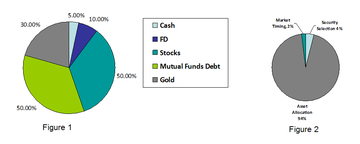Dealing with volatility in Investments
What ever goes up must come down, but it is difficult if its your money going down especially if you have invested at the peak.
So does anyone really know the peak? Can you time the market and make sure you don’t miss the bus? The answer is no you cannot time the market. And all investments will be subject to volatility.
The movement of the price of the instrument you have invested is called volatility. The up and down movement of the stock market is an eg of high volatility. The higher the volatility of the investment instrument higher the return and higher the risk.
Lower volatility, lower return , lower risk ( eg Bonds)
The only way to manage volatility is through diversification and asset allocation.
The Magic of Diversification
The practice of spreading money among different investments to reduce risk is known as diversification. By picking the right group of investments, you may be able to limit your losses and reduce the fluctuations of investment returns without sacrificing too much potential gain.
Diversifying your investment portfolio is one of the key ways you can handle market volatility. Because asset classes often perform differently under different market conditions, spreading your assets across a variety of different investments such as stocks, bonds, and cash alternatives (e.g., money market funds, CDs, and other short-term instruments), has the potential to help manage your overall risk. Ideally, a decline in one type of asset will be balanced out by a gain in another, though diversification can't guarantee a profit or eliminate the possibility of market loss.
One way to diversify your portfolio is through asset allocation.
Asset Allocation the Game Changer
An asset allocation is a strategy of dividing the portfolio among various asset classes so as to obtain the desired portfolio characteristics to suit distinct investor profiles. Apart form suiting the profile it also balances the risk of investments and there by the volatility of each investment category. Asset Allocation encompasses the following:
1) Selection of the asset classes
2) Proper blending of these asset classes in a portfolio
3) Managing the asset mix over time.
4) PPF, Equity Mutual Funds Debt Mutual Funds Gold equivalents are the most commonly used asset.
5) The asset allocation for an investor depends on the investors’ expectations of returns and the risk the investor is willing to take.
Timing of the market does not matter what matters is asset allocation. If investments are made with asset allocation in mind then even if the markets are highly volatile one can achieve the return desired. (refer figure 2)
Womantra Tips to Beat Volatility
1) Volatility will ALWAYS exist- Stay invested
2) Don’t put all your eggs in one basket
3) Rebalance your portfolio based on your time horizon
4) Diversification, Diversification, Diversification
5) Don’t lose sight of long term goals
6) Don’t let the media affect your investment
Mrin Agarwal & Rima H
Founders and Trainers Womantra
















